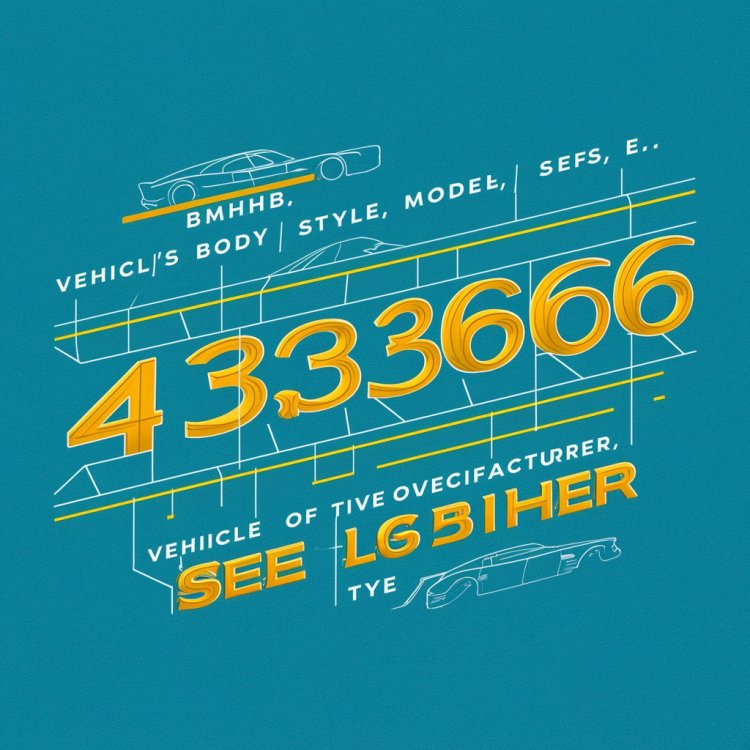The Vehicle Identification Number, or VIN, is a unique code assigned to every motor vehicle when it's manufactured. This alphanumeric identifier serves as the automotive equivalent of a fingerprint, providing crucial information about the vehicle's origin, make, model, and other significant details. A VIN decoder is a tool designed to interpret these codes, unlocking a treasure trove of information for car owners, buyers, mechanics, and enthusiasts. This article delves into the intricacies of VIN decoders, their functionality, importance, and the wealth of data they reveal.
The Anatomy of a VIN
A VIN is a 17-character string composed of both numbers and letters. This standardized format was adopted globally in 1981 to ensure consistency and accuracy across the automotive industry. Each segment of the VIN provides specific information:
- World Manufacturer Identifier (WMI): The first three characters represent the manufacturer and the country of origin. For instance, '1HG' stands for Honda manufactured in the United States.
- Vehicle Descriptor Section (VDS): Characters 4 to 8 describe the vehicle's model, body type, restraint system, transmission type, and engine code.
- Check Digit: The 9th character is a unique identifier that verifies the authenticity of the VIN.
- Vehicle Identifier Section (VIS): The last eight characters (10 to 17) include information about the vehicle's model year, plant of manufacture, and a unique serial number.
How VIN Decoders Work
A VIN decoder interprets each segment of the VIN, providing detailed information about the vehicle. These tools are available online, often free of charge, and are designed to be user-friendly. Users simply input the 17-character VIN, and the decoder processes the code, breaking it down into its constituent parts to reveal:
- Manufacturer details: The company that built the vehicle and its country of origin.
- Vehicle specifications: Information about the model, engine type, body style, and more.
- Production information: The year the vehicle was manufactured, the assembly plant, and the serial number.
The Importance of VIN Decoders
VIN decoders are invaluable tools for several reasons:
- Verification: Ensuring the VIN on a vehicle matches official records can prevent fraud. This is crucial when buying a used car.
- History Check: Decoding a VIN can help access a vehicle’s history report, revealing past accidents, repairs, or ownership changes.
- Maintenance and Repairs: Knowing the exact specifications of a vehicle helps in sourcing the correct parts and performing accurate maintenance.
- Recalls and Safety Information: Manufacturers often use VINs to identify vehicles affected by recalls. Decoding the VIN ensures owners are aware of any safety issues.
- Registration and Insurance: Accurate VIN information is essential for registering a vehicle and obtaining insurance.
How to Use a VIN Decoder
Using a VIN decoder is straightforward. Here’s a step-by-step guide:
- Locate the VIN: The VIN can typically be found on the driver’s side dashboard, visible through the windshield, or on the driver’s side door jamb. It may also be listed on the vehicle's title, registration, and insurance documents.
- Enter the VIN: Go to an online VIN decoder tool and enter the 17-character VIN into the search field.
- Review the Information: The decoder will process the VIN and display detailed information about the vehicle.
Common Uses of VIN Decoders
Buying a Used Car
One of the most common uses of a VIN decoder is in the process of purchasing a used car. Prospective buyers can use the decoder to verify the authenticity of the vehicle's details provided by the seller. This helps to ensure that the vehicle's make, model, and year match the seller's description and that there are no discrepancies.
Vehicle History Reports
VIN decoders are often used in conjunction with vehicle history reports. These reports provide a comprehensive overview of the vehicle's past, including any accidents, title issues, service records, and mileage. By decoding the VIN, buyers can gain insight into the vehicle's background and make more informed purchasing decisions.
Maintenance and Repairs
For vehicle owners, understanding the specifications of their car is crucial for proper maintenance and repairs. A VIN decoder can reveal details about the engine type, transmission, and other components, ensuring that the correct parts are used and that the vehicle is serviced appropriately.
Recall Information
Manufacturers issue recalls to address safety defects and non-compliance with safety standards. By decoding the VIN, vehicle owners can check if their car is subject to any recalls and take the necessary steps to have the issue resolved.
The Evolution of VIN Decoders
Over the years, VIN decoders have evolved to become more sophisticated and user-friendly. Initially, decoding a VIN required a manual process of cross-referencing the code with manufacturer charts. Today, advanced algorithms and extensive databases allow for instant decoding and detailed information retrieval.
Technological Advancements
Modern VIN decoders leverage technology to provide a seamless user experience. Features include:
- Mobile Applications: Many VIN decoders are available as mobile apps, allowing users to decode VINs on the go.
- Integration with Vehicle History Reports: Some VIN decoders are integrated with services that provide complete vehicle history reports.
- Enhanced Databases: Extensive databases ensure that even older vehicles and less common models can be accurately decoded.
Legal and Ethical Considerations
While VIN decoders are powerful tools, their use comes with certain legal and ethical considerations. Accessing a vehicle’s VIN is legal, as it is a publicly available identifier. However, using the information obtained from a VIN decoder for malicious purposes, such as identity theft or fraud, is illegal and unethical.
The Future of VIN Decoding
As technology continues to advance, the future of VIN decoding looks promising. Potential developments include:
- Enhanced Data Integration: Greater integration with global databases could provide even more detailed vehicle histories and specifications.
- Real-Time Updates: Continuous updates to VIN databases could ensure that the most current information is always available.
- Artificial Intelligence: AI could improve the accuracy and efficiency of VIN decoding, making it easier to interpret complex data.
Conclusion
VIN decoders are indispensable tools in the automotive world. Whether you are buying a used car, performing maintenance, or simply curious about your vehicle’s origins, a VIN decoder provides invaluable information. Understanding how to use these tools effectively can save time, money, and effort, ensuring that you make informed decisions about your vehicle. As technology continues to evolve, VIN decoders will only become more powerful, offering even greater insights into the unique identities of our vehicles.













